SpringBoot 实战 (十一) | 整合数据缓存 Cache
微信公众号:一个优秀的废人
前言
如题,今天介绍 SpringBoot 的数据缓存。做过开发的都知道程序的瓶颈在于数据库,我们也知道内存的速度是大大快于硬盘的,当需要重复获取相同数据时,一次又一次的请求数据库或者远程服务,导致大量时间耗费在数据库查询或远程方法调用上,导致性能的恶化,这便是数据缓存要解决的问题。
Spring 的缓存支持
Spring 定义了 org.springframework.cache.CacheManager 和 org.springframework.cache.Cache 接口用于统一不同的缓存技术。其中,CacheManager 是 Spring 提供的各种缓存技术的抽象接口,Cache 接口则是包含了缓存的各种操作(增加,删除,获取缓存,一般不会直接和此接口打交道)。
1、 Spring 支持的 CacheManager
针对不同的缓存技术,实现了不同的 CacheManager ,Spring 定义了下表所示的 CacheManager:
| CacheManager | 描述 |
|---|---|
| SimpleCacheManager | 使用简单的 Collection 来存储缓存,主要用于测试 |
| ConcurrentMapCacheManager | 使用 ConcurrentMap 来存储缓存 |
| NoOpCacheManager | 仅测试用途,不会实际缓存数据 |
| EhCacheCacheManager | 使用 EhCache 作为缓存技术 |
| GuavaCacheManager | 使用 Google Guava 的 GuavaCache 作为缓存技术 |
| HazelcastCacheManager | 使用 Hazelcast 作为缓存技术 |
| JCacheCacheManager | 支持 JCache(JSR-107) 标准的实现作为缓存技术,如 ApacheCommonsJCS |
| RedisCacheManager | 使用 Redis 作为缓存技术 |
在使用以上任意一个实现的 CacheManager 的时候,需注册实现的 CacheManager 的 Bean,如:
@Bean
public EhCacheCacheManager cacheManager(CacheManager
ehCacheCacheManager){
return new EhCacheCacheManager(ehCacheCacheManager);
}
注意,每种缓存技术都有很多的额外配置,但配置 cacheManager 是必不可少的。
2、 声明式缓存注解
Spring 提供了 4 个注解来声明缓存规则(又是使用注解式的 AOP 的一个例子)。4 个注解如下表示:
| 注解 | 解释 |
|---|---|
| @Cacheable | 在方法执行前 Spring 先查看缓存中是否有数据,若有,则直接返回缓存数据;若无数据,调用方法将方法返回值放入缓存中 |
| @CachePut | 无论怎样,都会将方法的返回值放到缓存中。 |
| @CacheEvict | 将一条或多条数据从缓存中删除 |
| @Caching | 可以通过 @Caching 注解组合多个注解策略在一个方法上 |
@Cacheable、@CachePut、@CacheEvict 都有 value 属性,指定的是要使用的缓存名称;key 属性指定的是数据在缓存中存储的键。
3、 开启声明式缓存支持
开启声明式缓存很简单,只需在配置类上使用 @EnableCaching 注解即可,例如:
@Configuration
@EnableCaching
public class AppConfig{
}
SpringBoot 的支持
在 Spring 中使用缓存技术的关键是配置 CacheManager ,而 SpringBoot 为我们配置了多个 CacheManager 的实现。
它的自动配置放在 org.springframework.boot.autoconfigure.cache 包中。
在不做任何配置的情况下,默认使用的是 SimpleCacheConfiguration ,即使用 ConcurrentMapCacheManager。SpringBoot 支持以前缀来配置缓存。例如:
spring.cache.type= # 可选 generic、ehcache、hazelcast、infinispan、jcache、redis、guava、simple、none spring.cache.cache-names= # 程序启动时创建的缓存名称 spring.cache.ehcache.config= # ehcache 配置文件的地址 spring.cache.hazelcast.config= # hazelcast配置文件的地址 spring.cache.infinispan.config= # infinispan配置文件的地址 spring.cache.jcache.config= # jcache配置文件的地址 spring.cache.jcache.provider= # 当多个 jcache 实现在类路径的时候,指定 jcache 实现 # 等等。。。
在 SpringBoot 环境下,使用缓存技术只需要在项目中导入相关缓存技术的依赖包,并在配置类中使用 @EnableCaching 开启缓存支持即可。
代码实现
本文将以 SpringBoot 默认的 ConcurrentMapCacheManager 作为缓存技术,演示 @Cacheable、@CachePut、@CacheEvict。
1、 准备工作
- IDEA
- JDK 1.8
- SpringBoot 2.1.3
2、 Pom.xml 文件依赖
<?xml version="1.0" encoding="UTF-8"?>
<project xmlns="http://maven.apache.org/POM/4.0.0" xmlns:xsi="http://www.w3.org/2001/XMLSchema-instance"
xsi:schemaLocation="http://maven.apache.org/POM/4.0.0 http://maven.apache.org/xsd/maven-4.0.0.xsd">
<modelVersion>4.0.0</modelVersion>
<parent>
<groupId>org.springframework.boot</groupId>
<artifactId>spring-boot-starter-parent</artifactId>
<version>2.1.3.RELEASE</version>
<relativePath/> <!-- lookup parent from repository -->
</parent>
<groupId>com.nasus</groupId>
<artifactId>cache</artifactId>
<version>0.0.1-SNAPSHOT</version>
<name>cache</name>
<description>cache Demo project for Spring Boot</description>
<properties>
<java.version>1.8</java.version>
</properties>
<dependencies>
<!-- cache 依赖 -->
<dependency>
<groupId>org.springframework.boot</groupId>
<artifactId>spring-boot-starter-cache</artifactId>
</dependency>
<!-- JPA 依赖 -->
<dependency>
<groupId>org.springframework.boot</groupId>
<artifactId>spring-boot-starter-data-jpa</artifactId>
</dependency>
<!-- web 启动类 -->
<dependency>
<groupId>org.springframework.boot</groupId>
<artifactId>spring-boot-starter-web</artifactId>
</dependency>
<!-- mysql 数据库连接类 -->
<dependency>
<groupId>mysql</groupId>
<artifactId>mysql-connector-java</artifactId>
<scope>runtime</scope>
</dependency>
<!-- lombok 依赖,简化实体 -->
<dependency>
<groupId>org.projectlombok</groupId>
<artifactId>lombok</artifactId>
<optional>true</optional>
</dependency>
<!-- 单元测试类 -->
<dependency>
<groupId>org.springframework.boot</groupId>
<artifactId>spring-boot-starter-test</artifactId>
<scope>test</scope>
</dependency>
</dependencies>
<build>
<plugins>
<plugin>
<groupId>org.springframework.boot</groupId>
<artifactId>spring-boot-maven-plugin</artifactId>
</plugin>
</plugins>
</build>
</project>
注释很清楚,无需多言。不会就谷歌一下。
3、 Application.yaml 文件配置
spring:
# 数据库相关
datasource:
driver-class-name: com.mysql.cj.jdbc.Driver
url: jdbc:mysql://127.0.0.1:3306/test?useUnicode=true&characterEncoding=utf8&serverTimezone=UTC&useSSL=true
username: root
password: 123456
# jpa 相关
jpa:
hibernate:
ddl-auto: update # ddl-auto: 设为 create 表示每次都重新建表
show-sql: true
4、 实体类
package com.nasus.cache.entity;
import javax.persistence.Entity;
import javax.persistence.GeneratedValue;
import javax.persistence.Id;
import lombok.AllArgsConstructor;
import lombok.Data;
import lombok.NoArgsConstructor;
@Data
@Entity
@AllArgsConstructor
@NoArgsConstructor
public class Student {
@Id
@GeneratedValue
private Integer id;
private String name;
private Integer age;
}
5、 dao 层
package com.nasus.cache.repository;
import com.nasus.cache.entity.Student;
import org.springframework.data.jpa.repository.JpaRepository;
import org.springframework.stereotype.Repository;
@Repository
public interface StudentRepository extends JpaRepository<Student,Integer> {
}
6、 service 层
package com.nasus.cache.service;
import com.nasus.cache.entity.Student;
public interface StudentService {
public Student saveStudent(Student student);
public void deleteStudentById(Integer id);
public Student findStudentById(Integer id);
}
实现类:
package com.nasus.cache.service.impl;
import com.nasus.cache.entity.Student;
import com.nasus.cache.repository.StudentRepository;
import com.nasus.cache.service.StudentService;
import org.slf4j.Logger;
import org.slf4j.LoggerFactory;
import org.springframework.beans.factory.annotation.Autowired;
import org.springframework.cache.annotation.CacheEvict;
import org.springframework.cache.annotation.CachePut;
import org.springframework.cache.annotation.Cacheable;
import org.springframework.stereotype.Service;
@Service
public class StudentServiceImpl implements StudentService {
// 使用 slf4j 作为日志框架
private static final Logger LOGGER = LoggerFactory.getLogger(StudentServiceImpl.class);
@Autowired
private StudentRepository studentRepository;
@Override
@CachePut(value = "student",key = "#student.id")
// @CachePut 缓存新增的或更新的数据到缓存,其中缓存名称为 student 数据的 key 是 student 的 id
public Student saveStudent(Student student) {
Student s = studentRepository.save(student);
LOGGER.info("为id、key 为{}的数据做了缓存", s.getId());
return s;
}
@Override
@CacheEvict(value = "student")
// @CacheEvict 从缓存 student 中删除 key 为 id 的数据
public void deleteStudentById(Integer id) {
LOGGER.info("删除了id、key 为{}的数据缓存", id);
//studentRepository.deleteById(id);
}
@Override
@Cacheable(value = "student",key = "#id")
// @Cacheable 缓存 key 为 id 的数据到缓存 student 中
public Student findStudentById(Integer id) {
Student s = studentRepository.findById(id).get();
LOGGER.info("为id、key 为{}的数据做了缓存", id);
return s;
}
}
代码讲解看注释,很详细。
7、 controller 层
package com.nasus.cache.controller;
import com.nasus.cache.entity.Student;
import com.nasus.cache.service.StudentService;
import org.springframework.beans.factory.annotation.Autowired;
import org.springframework.web.bind.annotation.DeleteMapping;
import org.springframework.web.bind.annotation.GetMapping;
import org.springframework.web.bind.annotation.Mapping;
import org.springframework.web.bind.annotation.PathVariable;
import org.springframework.web.bind.annotation.PostMapping;
import org.springframework.web.bind.annotation.RequestBody;
import org.springframework.web.bind.annotation.RequestMapping;
import org.springframework.web.bind.annotation.RestController;
@RestController
@RequestMapping("/student")
public class StudentController {
@Autowired
private StudentService studentService;
@PostMapping("/put")
public Student saveStudent(@RequestBody Student student){
return studentService.saveStudent(student);
}
@DeleteMapping("/evit/{id}")
public void deleteStudentById(@PathVariable("id") Integer id){
studentService.deleteStudentById(id);
}
@GetMapping("/able/{id}")
public Student findStudentById(@PathVariable("id") Integer id){
return studentService.findStudentById(id);
}
}
8、 application 开启缓存功能
package com.nasus.cache;
import org.springframework.boot.SpringApplication;
import org.springframework.boot.autoconfigure.SpringBootApplication;
import org.springframework.cache.annotation.EnableCaching;
@EnableCaching // 开启缓存功能
@SpringBootApplication
public class CacheApplication {
public static void main(String[] args) {
SpringApplication.run(CacheApplication.class, args);
}
}
测试
测试前,先看一眼数据库当前的数据,如下:
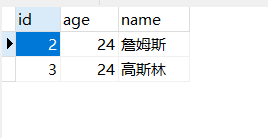
1、 测试 @Cacheable
访问 http://localhost :8080/student/able/2 控制台打印出了 SQL 查询语句,以及指定日志。说明这一次程序是直接查询数据库得到的结果。
2019-02-21 22:54:54.651 INFO 1564 --- [nio-8080-exec-1] o.s.web.servlet.DispatcherServlet : Completed initialization in 11 ms Hibernate: select student0_.id as id1_0_0_, student0_.age as age2_0_0_, student0_.name as name3_0_0_ from student student0_ where student0_.id=? 2019-02-21 22:54:59.725 INFO 1564 --- [nio-8080-exec-1] c.n.c.service.impl.StudentServiceImpl : 为id、key 为2的数据做了缓存
postman 第一次测试结果 :
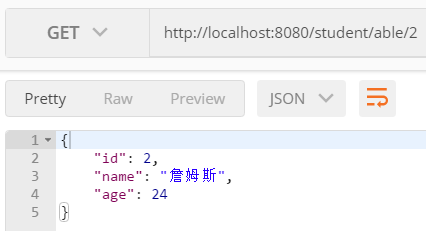
再次访问 http://localhost :8080/student/able/2 结果如下图。但控制台无 SQL 语句打印,也无 为id、key 为2的数据做了缓存 这句话输出。
说明 @Cacheable 确实做了数据缓存,第二次的测试结果是从数据缓存中获取的,并没有直接查数据库。
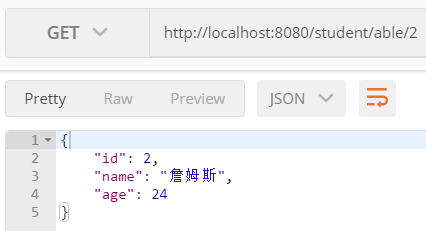
2、 测试 @CachePut
如下图,postman 访问 http://localhost:8080/student/put 插入数据:

下面是控制台打印出了 SQL Insert 插入语句,以及指定日志。说明程序做了缓存。
Hibernate: insert into student (age, name, id) values (?, ?, ?) 2019-02-21 23:12:03.688 INFO 1564 --- [nio-8080-exec-8] c.n.c.service.impl.StudentServiceImpl : 为id、key 为4的数据做了缓存
插入数据返回的结果:
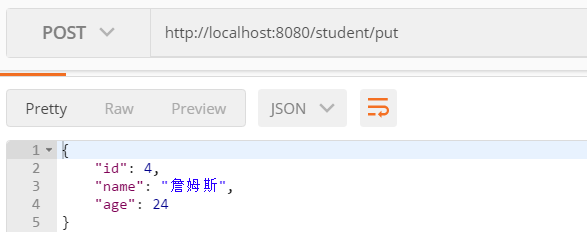
数据库中的结果:
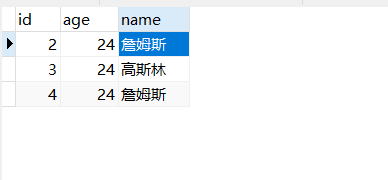
访问 http://localhost :8080/student/able/4 Postman 结果如下图。控制台无输出,验证了 @CachePut 确实做了缓存,下图数据是从缓存中获取的。
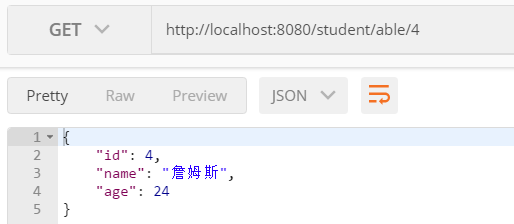
3、 测试 @CacheEvict
postman 访问 http://localhost :8080/student/able/3 为 id = 3 的数据做缓存。
postman 再次访问 http://localhost :8080/student/able/3 确认数据是从缓存中获取的。
postman 访问 http://localhost :8080/student/evit/3

从缓存中删除 key 为 3 的缓存数据:
Hibernate: select student0_.id as id1_0_0_, student0_.age as age2_0_0_, student0_.name as name3_0_0_ from student student0_ where student0_.id=? 2019-02-21 23:26:08.516 INFO 8612 --- [nio-8080-exec-2] c.n.c.service.impl.StudentServiceImpl : 为id、key 为3的数据做了缓存 2019-02-21 23:27:01.508 INFO 8612 --- [nio-8080-exec-4] c.n.c.service.impl.StudentServiceImpl : 删除了id、key 为3的数据缓存
再次 postman 访问 http://localhost :8080/student/able/3 观察后台,重新做了数据缓存:
Hibernate: select student0_.id as id1_0_0_, student0_.age as age2_0_0_, student0_.name as name3_0_0_ from student student0_ where student0_.id=? 2019-02-21 23:27:12.320 INFO 8612 --- [nio-8080-exec-5] c.n.c.service.impl.StudentServiceImpl : 为id、key 为3的数据做了缓存
这一套测试流程下来,证明了 @CacheEvict 确实删除了数据缓存。
源码下载
https://github.com/turoDog/Demo/tree/master/springboot_cache_demo
切换缓存技术
切换缓存技术除了在 pom 文件加入相关依赖包配置以外,使用方式与上面的代码演示一样。
1、 切换 EhCache
在 pom 中添加 Encache 依赖:
<!-- EhCache 依赖 -->
<dependency>
<groupId>net.sf.ehcache</groupId>
<artifactId>ehcache</artifactId>
</dependency>
Ehcache 所需配置文件 ehcache.xml 只需放在类路径(resource 目录)下,SpringBoot 会自动扫描,如:
<?xml version="1.0" encoding="UTF-8">
<ehcache>
<cache name="student" maxElementsInMmory="1000">
<ehcache>
SpringBoot 会自动配置 EhcacheManager 的 Bean。
2、 切换 Guava
只需在 pom 中加入 Guava 依赖即可:
<!-- GuavaCache 依赖 -->
<dependency>
<groupId>com.google.guava</groupId>
<artifactId>guava</artifactId>
<version>18.0</version>
</dependency>
SpringBoot 会自动配置 GuavaCacheManager 的 Bean。
3、 切换 RedisCache
与 Guava 一样,只需在 pom 加入依赖即可:
<!-- cache 依赖 -->
<dependency>
<groupId>org.springframework.boot</groupId>
<artifactId>spring-boot-starter-redis</artifactId>
</dependency>
SpringBoot 会自动配置 RedisCacheManager 以及 RedisTemplate 的 Bean。
此外,切换其他缓存技术的方式也是类似。这里不做赘述。
后语
以上为 SpringBoot 数据缓存的教程。
如果本文对你哪怕有一丁点帮助,请帮忙点好看。
你的好看是我坚持写作的动力。
另外,关注之后在发送 1024 可领取免费学习资料。资料内容详情请看这篇旧文: Python、C++、Java、Linux、Go、前端、算法资料分享

- 本文标签: ssl servlet description redis App 开发 entity 免费 数据缓存 springboot mysql root find 数据 CTO dependencies src 下载 cache Spring Boot linux web pom tar UI 注释 REST dist python plugin id apache maven js 配置 时间 谷歌 build ACE bean Master 2019 update db https map 代码 value schema Word Service AOP UTC java tab git sql GitHub key dataSource 删除 Persistence Collection 单元测试 spring 源码 struct cat Google XML provider http 微信公众号 IO 缓存 测试 ip 数据库 IDE Select final DDL JPA NIO JDBC 目录
- 版权声明: 本文为互联网转载文章,出处已在文章中说明(部分除外)。如果侵权,请联系本站长删除,谢谢。
- 本文海报: 生成海报一 生成海报二











![[HBLOG]公众号](https://www.liuhaihua.cn/img/qrcode_gzh.jpg)

